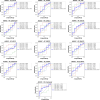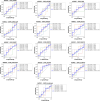StackNAFLD: An Accurate Stacking Ensemble Learning Targeting NAFLD Treatment
- PMID: 40893275
- PMCID: PMC12391961
- DOI: 10.1021/acsomega.5c01473
StackNAFLD: An Accurate Stacking Ensemble Learning Targeting NAFLD Treatment
Abstract
Nonalcoholic fatty liver disease (NAFLD) is a slow-progressing yet complex disease with multiple pathophysiological mechanisms that make it challenging to treat. In this study, we developed a machine learning (ML)-based stacking ensemble model to predict molecules that could inhibit NAFLD progression utilizing data from animal experiments. We systematically collected 75 agents from preclinical experiments and classified them as inducers and inhibitors based on each study end point. Then, we computed 12 sets of molecular fingerprints and trained them with three baseline ML models. After that, the stacked model was trained using the predictive features from the baseline models and validated with 5-fold cross-validation (5-CV) and leave-one-out cross-validation (LOOCV). We found that the stacked model outperformed its baseline model across various evaluation metrics, thereby improving the prediction of the NAFLD inhibitory activity. Additionally, we tested the robustness and applicability domain of the stacked model, ensuring that this model delivered a trustworthy prediction. Moreover, we highlighted key molecular features, such as carboxylic, alkene, or aromatic rings, underscoring their influence on the decision-making of the stacked model. In conclusion, we have provided an effective method for improving molecular property prediction by using the stacking ensemble learning approach. Furthermore, we hosted our software in an open-access GitHub repository for further reproducibility and use in the drug discovery pipeline.
© 2025 The Authors. Published by American Chemical Society.
Figures












Similar articles
-
Prescription of Controlled Substances: Benefits and Risks.2025 Jul 6. In: StatPearls [Internet]. Treasure Island (FL): StatPearls Publishing; 2025 Jan–. 2025 Jul 6. In: StatPearls [Internet]. Treasure Island (FL): StatPearls Publishing; 2025 Jan–. PMID: 30726003 Free Books & Documents.
-
Survivor, family and professional experiences of psychosocial interventions for sexual abuse and violence: a qualitative evidence synthesis.Cochrane Database Syst Rev. 2022 Oct 4;10(10):CD013648. doi: 10.1002/14651858.CD013648.pub2. Cochrane Database Syst Rev. 2022. PMID: 36194890 Free PMC article.
-
Comparison of Two Modern Survival Prediction Tools, SORG-MLA and METSSS, in Patients With Symptomatic Long-bone Metastases Who Underwent Local Treatment With Surgery Followed by Radiotherapy and With Radiotherapy Alone.Clin Orthop Relat Res. 2024 Dec 1;482(12):2193-2208. doi: 10.1097/CORR.0000000000003185. Epub 2024 Jul 23. Clin Orthop Relat Res. 2024. PMID: 39051924
-
Does the Presence of Missing Data Affect the Performance of the SORG Machine-learning Algorithm for Patients With Spinal Metastasis? Development of an Internet Application Algorithm.Clin Orthop Relat Res. 2024 Jan 1;482(1):143-157. doi: 10.1097/CORR.0000000000002706. Epub 2023 Jun 12. Clin Orthop Relat Res. 2024. PMID: 37306629 Free PMC article.
-
Cost-effectiveness of using prognostic information to select women with breast cancer for adjuvant systemic therapy.Health Technol Assess. 2006 Sep;10(34):iii-iv, ix-xi, 1-204. doi: 10.3310/hta10340. Health Technol Assess. 2006. PMID: 16959170
References
-
- Chalasani N., Younossi Z., Lavine J. E., Charlton M., Cusi K., Rinella M., Harrison S. A., Brunt E. M., Sanyal A. J.. The diagnosis and management of nonalcoholic fatty liver disease: Practice guidance from the American Association for the Study of Liver Diseases. Hepatology. 2018;67:328–357. doi: 10.1002/hep.29367. - DOI - PubMed
-
- European Association for the Study of the Liver (EASL); European Association for the Study of the Liver (EASL); European Association for the Study of the Liver (EASL) EASL–EASD–EASO Clinical Practice Guidelines for the management of non-alcoholic fatty liver disease. J. Hepatol. 2016;64:1388–1402. doi: 10.1016/j.jhep.2015.11.004. - DOI - PubMed
LinkOut - more resources
Full Text Sources
